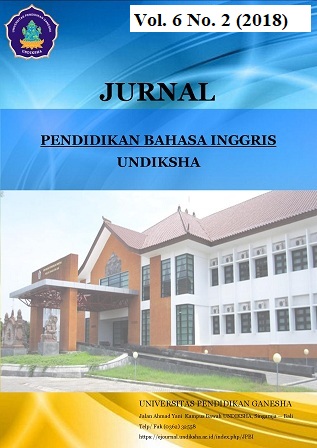Affixation System in Penglipuran Dialect: A Descriptive Study of Derivational and Inflectional Processes
DOI:
https://doi.org/10.23887/jpbi.v6i2.20588Abstract
Abstract
This study aimed at describing the prefixes and suffixes in Penglipuran Dialect which belong to derivation and inflection. This research was a descriptive qualitative research. The data were collected using three techniques, namely observation, recording technique, and interview (listening and noting) technique. Three informants sample from Penglipuran were chosen based on criteria. The criteria of the informants are: they are smart, they have communicative competence, they have enough knowledge about the topic, they are the native speakers of the Penglipuran village, they are patient, they have high-attention, they have enough time to be interviewed, they are not having disturbances related to speech organs, they are a good listener, they are able to answer the questions, they are confident and they are proud of their language and culture. The results of the study showed that there were six kinds of prefixes in Penglipuran Dialect such as prefix {mə-}, {m-}, {n-}, {ŋ-}, {ñ-}, and {ə-} and there were three kinds of suffixes in Penglipuran Dialect such as {-Λŋ}, {-In} and, {-ɔ}. Prefixes and suffixes in Penglipuran Dialect which belong to derivation were prefix {mə-} and {m-} and suffix {-Λŋ} and {-Ιn}. Prefixes and suffixes in Penglipuran Dialek which belong to inflection were prefix {n-}, {ŋ-}, {ñ-}, {m-}, and {ə-} and suffix {-ɔ}, {-Λŋ}, and {-In}.
Key Words: affixation, Penglipuran Dialect, derivational and inflectional processes
References
Bawa, I W and Jendra, I W. 1981. Struktur Bahasa Bali. Pusat Pembinaan dan Pengembangan Bahasa Jakarta: Departemen Pendidikan dan Kebudayaan.
Budasi, I G. 2007. Kekerabatan Bahasa-bahasa di Sumba (Suatu Kajian Linguistik Hipotesis Komperatif) (Disertasi). Yogyakarta: Fakultas Pascasarjana Universitas Gajah Mada.
Brahmadyantara, Petrus I Wayan. 2014. An Analysis Of Balinese Inflectional And Derivational Affixes Of Balinese Tambakan Dialect. Fakultas Bahasa dan Seni Universitas Pendidikan Ganesha. (S1 Thesis)
Carstairs, McCarthy. 2002. An Introduction to English Morphology: Words and Their Structure. Edinburgh University Press. Edinburgh: Edinburgh University Press Ltd 22 George Square.
Delahunty, Garvey. 2010. The English Language from Sound to Sense. Colorado: The WAC Clearinghouse, Fort Collins, 80523-1052.
Emmitt, M and Pollock, J. 1997. Language and Learning: An Introduction for Teaching. New York. Oxford University Press
Katamba. 1994. English Words. Francis: London and New York: Routledge.
Keraf, Gorys. 1996. Linguistik Bandingan Historis. Jakarta: PT. Gramedia Pustaka Utama.
Kridalaksana, H. 1996. Pembentukan Kata Dalam Bahasa Indonesia, Edisi 2. Jakarta: Gramesia Pustaka Utama
Kurnia, Sari.2009. The phonological System of Loloan Dialect: A Synchronic Study. Fakultas Bahasa dan Seni Universitas Pendidikan Ganesha. (S1 Thesis)
Miles, A and Huberman, M. 1994. Qualitative Data Analysis, 2nd Edition. California: Sage Publication
Putra, I Gede Andre.2014.Affixation System in Munti Gunung Dialect: A Descriptive Study of Derivational and Inflectional Processes.Singaraja: Fakultas Pendidikan Bahasa Inggris. (S1 thesis)
Roach.P. 2003.Phonetics. New York: Oxford University Press
Sari Widya, Ketut 2010 The phonological System Of Munti Gunung Dialect :A Descriptve Qualitative Study .Singaraja : Fakultas Bahasa dan Seni Universitas Pendidikan Ganesha. (S1 Thesis).
Seken, I Ketut. 1992. Introduction to Linguistics. Program Studi Pendidikan Bahasa Inggris Fakultas Keguruan dan Ilmu Pendidikan Universitas Udayana.
Suparman, Tatang. 2008. Proses Morphologis Dalam Bahasa Indonesi (Analisi Bahasa Karya Samsuri). Bandung: Fakultas Sastra Universitas Padjadjaran.
Sutisna, I Putu Edi.2014. 3.A Comparative Study On Morphological Process of Tambakan and Pelaga Dialects.Singaraja:Fakultas Pendidikan Bahasa Inggris. (S1 Thesis)
Trudgill. P. (1983). Sociolinguistios: An Introduction to Language and Society. Britain: Great Britain
Wiranata, I Wayan. 2014. The Phonological System Of Tambakan Dialect: A Descriptive Qualitative Study.Singaraja:Fakultas Pendidikan Bahasa Inggris. (S1 Thesis)
Wiweka, I Wayan Adi. 2014. Inflectional and Derivational Morphemes of Pelaga Dialect: A Descriptive Qualitative Study. Singaraja:Fakultas Pendidikan Bahasa Inggris. (S1 Thesis)
http://faculty.unlv.edu/nagelhout/ENG411Bs12C/mod1concept2.html.
Accessed on May 10, 2013
http://www.uncp.edu/home/canada/work/caneng/morpheme.html.
Accessed on May 17, 2013
http://nurarifs.blogspot.com/2011/09/morphophonemic-process.html
Accessed on May 17, 2013
http://lgzsoldos.blogspot.com/2011/03/inflectional-affixes-of-english.html
Accessed on May 17, 2013
http://morphophonemic.askdefine.com/
Accessed on May 17, 2013
http://dictionary.reference,com/browse/dialect
Accessed on May 18, 2013
http://grammar.about.com/od/ab/g/boundmorphterm.htm.
Accessed on May 18, 2013
http://dictionary.reference,com/browse/dialect.
Accessed on October 18, 2013
http://www.mapsofall.com/munti-gunung-38516217.html
Accessed On October 18, 2013
http://popularlinguisticsonline.org/2011/01/morphology-how-are-words-formed/
Accessed on January 03, 2014
http://www.merriam-webster.com/dictionary/dialect
Accessed on January 03, 2014
Downloads
Published
Issue
Section
License
Authors who publish with the Jurnal Pendidikan Bahasa Inggris Undiksha agree to the following terms:- Authors retain copyright and grant the journal the right of first publication with the work simultaneously licensed under a Creative Commons Attribution License (CC BY-SA 4.0) that allows others to share the work with an acknowledgment of the work's authorship and initial publication in this journal
- Authors are able to enter into separate, additional contractual arrangements for the non-exclusive distribution of the journal's published version of the work (e.g., post it to an institutional repository or publish it in a book), with an acknowledgment of its initial publication in this journal.
- Authors are permitted and encouraged to post their work online (e.g., in institutional repositories or on their website) prior to and during the submission process, as it can lead to productive exchanges, as well as earlier and greater citation of published work. (See The Effect of Open Access)













